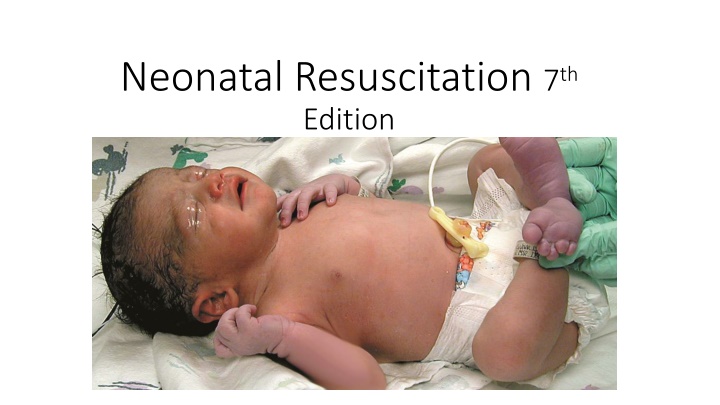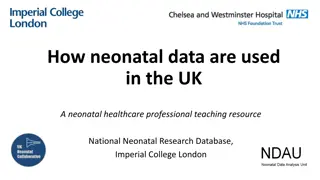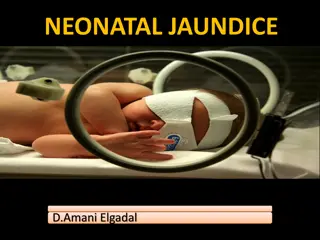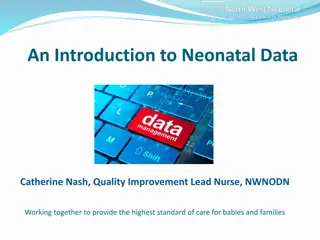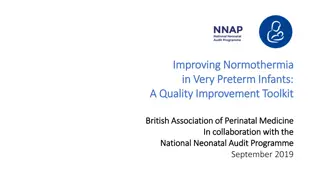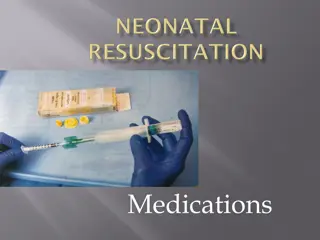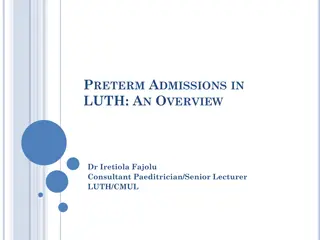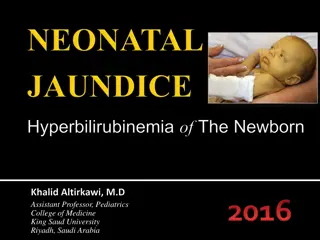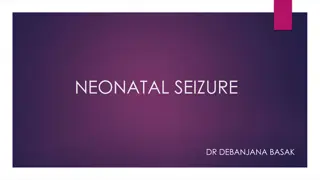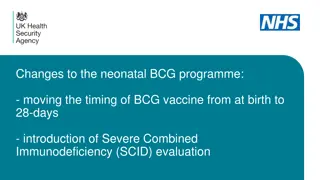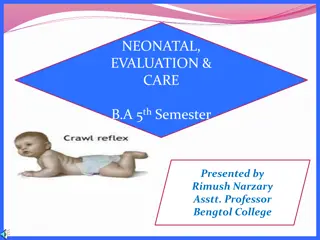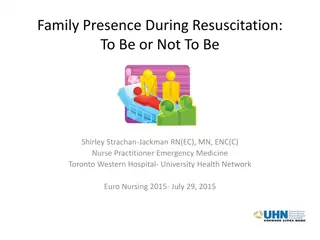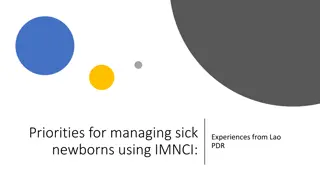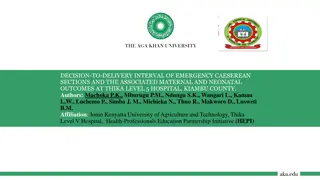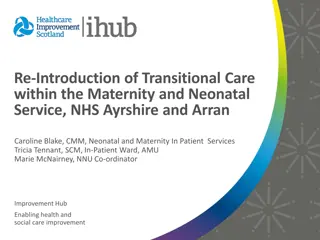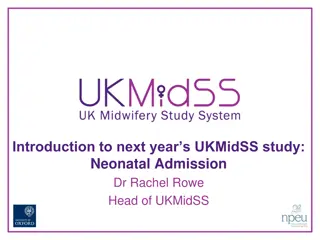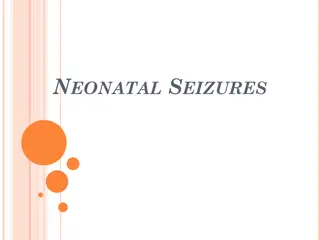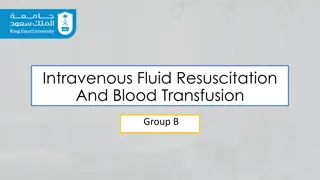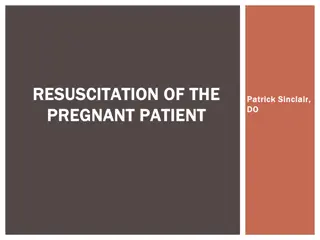Neonatal Resuscitation Guidelines and Protocols
Detailed information on neonatal resuscitation techniques and protocols from the 7th edition guide. Covers topics such as interrupted transitions, resuscitation flow diagram steps, perinatal risk factors, questions to ask before birth, initial steps of newborn care, and more. Emphasizes the importance of being prepared to resuscitate every newborn, highlighting antepartum and intrapartum factors that may indicate at-risk babies.
Uploaded on Sep 17, 2024 | 0 Views
Download Presentation

Please find below an Image/Link to download the presentation.
The content on the website is provided AS IS for your information and personal use only. It may not be sold, licensed, or shared on other websites without obtaining consent from the author.If you encounter any issues during the download, it is possible that the publisher has removed the file from their server.
You are allowed to download the files provided on this website for personal or commercial use, subject to the condition that they are used lawfully. All files are the property of their respective owners.
The content on the website is provided AS IS for your information and personal use only. It may not be sold, licensed, or shared on other websites without obtaining consent from the author.
E N D
Presentation Transcript
Neonatal Resuscitation 7th Edition
Interrupted Normal Transition Depressed respiratory effort apnea or tachypnea Compromised heart bradycardia or tachycardia Decreased muscle tone Low oxygen saturation Low blood pressure Normal transition Interrupted transition p. 8
Resuscitation Flow Diagram Steps to evaluate and resuscitate a newborn: 5 blocks: Initial assessment Airway (A) Breathing (B) Circulation (C) Drugs (D) Diamonds indicate ASSESSMENT Rectangles show ACTION p. 9
Be Prepared to Resuscitate Every Newborn Always be prepared! Antepartum and intrapartum factors will help identify some at-risk babies Some babies who need resuscitation have no risk factors p. 18
Perinatal Risk Factors Antepartum factors: Preterm or post term dates Maternal diabetes Hypertension Bleeding Maternal infection Malaria, HIV, etc. Premature rupture of membranes Multiple gestation Others Intrapartum factors: Instrumented delivery Breech presentation Premature labor Chorioamnionitis Meconium Prolapsed or nuchal cord Shoulder dystocia Significant bleeding Others p. 18
Questions Before Birth Before birth, ask the obstetrical provider the following key questions: 1. What is the expected gestation? 2. Is the amniotic fluid clear? 3. Additional risk factors? 4. Umbilical cord management plan?
Initial Steps of Newborn Initial Steps of Newborn Care Care You will learn about: Rapid assessment of the newborn Initial steps of newborn care If additional steps are required Persistent cyanosis or labored breathing Use of pulse oximeter if available Giving supplemental oxygen Continuous positive airway pressure Actions for meconium-stained amniotic fluid p. 33
Birth and Umbilical Cord Birth and Umbilical Cord Clamping Clamping Mark the time of birth when last fetal part emerges from mother s body Current evidence shows delaying cord clamping to 30-60 second benefits baby (if placental circulation intact) Before birth establish plan with obstetric provider for timing of umbilical cord clamping p. 36
Evaluating the Newborn Immediately after birth, the following questions must be asked: Term gestation Good tone Breathing or crying p. 37-38
Initial Steps of Newborn Care Initial Steps of Newborn Care For a vigorous term newborn Provide warmth with mother or under radiant warmer Position head and neck to open airway If needed, clear secretions Dry Stimulate
Routine Care Routine Care 90% of newborns are vigorous term babies with no risk factors Should remain with mothers to promote bonding, initiate breastfeeding and receive newborn care
Opening the Airway Opening the Airway Position baby on back Slightly extend the neck in sniffing position Avoid hyperextension or flexion of the baby s neck p. 40-41
Opening the Airway Opening the Airway p. 40-41
If Needed, Clear Secretions from If Needed, Clear Secretions from Airway Airway Wipe nose and mouth with towel If necessary, gently suction with a bulb syringe. Suction mouth first, then nose M before N Brief, gentle suctioning is usually adequate Vigorous suction may injure tissues and cause bradycardia or apnea p. 41-42
Dry and Stimulate Dry thoroughly Remove wet linen Reposition the head Click on the image to play video
Stimulate Breathing Stimulate Breathing If baby is still not breathing gently rub the baby s back, trunk or extremities for a few seconds. If apnea remains, begin PPV
Harmful Forms of Stimulation Harmful Forms of Stimulation Slapping back or buttocks Shaking Continued tactile stimulation in a baby who is not breathing wastes valuable time. For persistent apnea, give positive- pressure ventilation promptly!
Assess Newborns Response Assess Newborn s Response Respirations: Is baby breathing or crying? If baby is not breathing or is gasping proceed to PPV Heart rate: Is HR more than 100 bpm? Listen with a stethoscope on left side of chest Count number of beats in 6 seconds and multiply by 10 Tap out HR with your finger If available, use pulse oximeter or ECG monitor
Evaluate the Baby: Evaluate the Baby: Respirations and Heart Rate Respirations and Heart Rate p. 45, 48
Not Breathing Heart Rate Low Not Breathing Heart Rate Low Start PPV if baby is not breathing Start PPV if baby appears to be breathing but heart rate below 100 Call for immediate additional help if you are the only provider If baby has not responded to initial steps in first minute of life proceed to PPV
Breathing, HR 100, Cyanosis Breathing, HR 100, Cyanosis Cyanosis administer free-flow oxygen adjusting concentration guided by pulse oximetry. Gradually decrease oxygen as baby s condition improves. Labored breathing or persistent low oxygen saturation try continuous positive airway pressure (CPAP) or PPV p. 46
Central Cyanosis and Acrocyanosis Central Cyanosis and Acrocyanosis
Oximetry Oximetry If available, use a pulse oximeter to guide your treatment when resuscitation is anticipated. Stabilization of ventilation, HR, and oxygenation are priorities Place oximeter probe on right arm for pre-ductal measurement
Supplemental Oxygen Supplemental Oxygen Begin with room air Guided by oximetry (visual assessment of skin color is not reliable) Preterm may need supplemental oxygen earlier p. 48
Free Free- -Flow Oxygen Flow Oxygen Self-inflating bag and mask - tail Oxygen tubing Flow-inflating bag and mask
